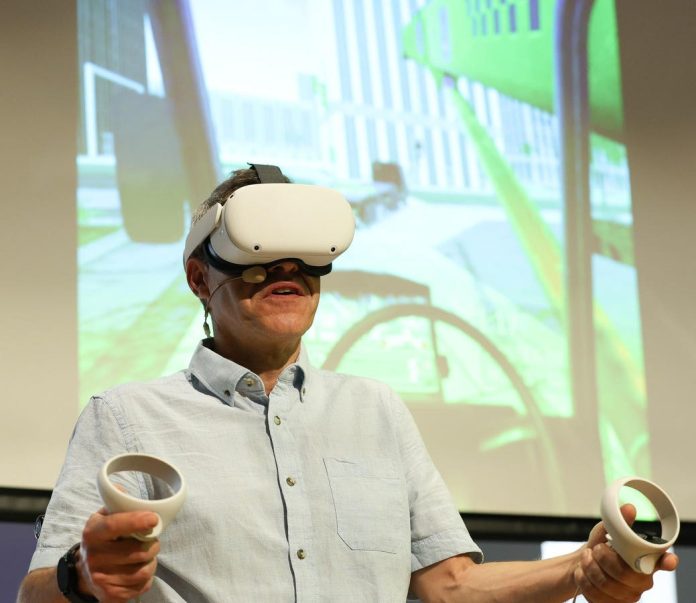
MADRID, SPAIN – JUNE 16: A man wears virtual reality glasses during the meeting ‘The digital … More revolution of employment’, in the Auditorium of Espacio Fundacion Telefonica, on 16 June, 2023 in Madrid, Spain. This meeting addresses the role of training and digital talent in the digital transformation of three of the key productive sectors: construction, transport and agri-food and horticulture. The conference is part of ‘Professionals 4.0’, a project of Fundacion Telefonica together with CEOE that, in collaboration with Fundacion Laboral en la Construccion, Astic, Confebus and FEPEX, aims to promote training in digital skills of more than 36,000 professionals in these three sectors through the ‘Nanograds 4.0’. (Photo By Marta Fernandez Jara/Europa Press via Getty Images)
The United States is facing an unprecedented shortage of factory workers. There is one qualified worker for every 20 open factory jobs, David Gitlin, CEO of Carrier, an HVAC equipment maker, told The New York Times. And this is before we see the effects of President Trump’s tariff policy, which has a stated goal of bringing even more manufacturing jobs to the U.S.
There are many reasons for the shortage. Blue collar workers are hitting retirement age, and a trend in recent years toward pushing more students to attend college means that fewer of them are participating in apprenticeship programs or going directly to learn on the job. There is now a glut of young, college educated workers who are unemployed, but their skills can’t easily transfer to manufacturing jobs. Far from the image some might have of factory work being easy or repetitive, most current manufacturing jobs are technical and complex, requiring extensive training and a high degree of skill.
This isn’t going to be solved overnight, but two emerging technologies could provide a solution that speeds up the process. Virtual reality training, which has been adopted by companies like Walmart and Exxon to train workers in a variety of skills, could be deployed at scale to reach new workers and upskill them quickly.
While this training benefits everyone, it is especially useful for younger audiences, who are used to interactive content and video games. Headsets are still seen as a differentiating factor, and could be a useful tool for recruitment. Making job training a game, as opposed to a slog, could go a long way to getting young people interested in factory work.
VR training has been shown to be 30% faster than traditional training at reaching skill proficiency, not to mention increasing employee engagement by 40% and reducing error rates by 20%. It has the added benefit of allowing trainees to fail safely — if someone is training on an expensive piece of equipment and makes a mistake, it could result in injury, or at least a costly repair and downtime. If they make a mistake in a virtual reality training program, all they need to do is restart the simulation.
VR training also allows companies to train large numbers of people at scale, and lets them train on their own time. In-person training has built-in limits — only a certain number of people could use a machine or fit in a room at once, but training in a virtual environment means that a near infinite number of people can be in the program at the same time. Additionally, human trainers need to go home at the end of the day, whereas a VR training program can be used any time, and as many times as the user needs to get it right.
Companies have been put off by the high cost of creating training programs, but artificial intelligence provides a solution. There are several programs in the market that allow users to create scenarios by inputting and refining prompts. Engage, for example, lets people build digital twins of their environments and add 3D objects by using voice commands. Other companies, like Connexions, let you create virtual humans and have interactive conversations powered by AI. While Connexions is focused on the healthcare space, the technology could be used in any industry. After all, factories don’t just need frontline workers; they need managers who can successfully motivate teams.
In instances where AI content might not work, factory workers can use 360 cameras to capture environments and no-code programs like Uptale to add interactivity to the scenarios. 360 cameras are relatively affordable, usually a few hundred dollars, and once workers are trained to use them and use a no-code tool, they can start creating training at scale.
Making training for these jobs accessible will go a long way toward revitalizing communities and getting people who might have fallen on hard times or left the labor force back into the job market. It will also assure that American manufacturing continues to thrive and provide good jobs and growth opportunities.
